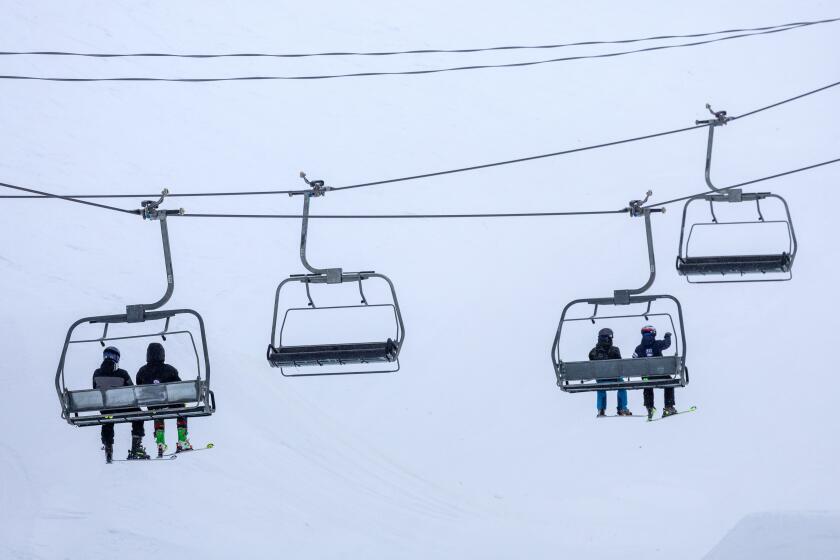Nora Batters Inland Areas as Flooding Closes Roads
- Share via
Imperial County was inundated Wednesday night with flash flooding that washed away power poles and flooded homes and roads as the leading edge of Hurricane Nora battered inland areas of Southern California.
Conditions in the El Centro area were expected to worsen early today as the storm moved slowly northward. On Wednesday, it generated 95-mph winds and massive ocean waves and punished the west coast of Mexico’s Baja California peninsula.
At least 16 power poles were washed away Thursday night in Seeley, just west of El Centro, said Jon Erdman, a meteorologist for WeatherData Inc., which provides forecasts for The Times. A few homes were flooded and several roads in the area were closed.
“This isn’t even the heaviest rains yet,” Erdman said. “We’re expecting heavier rains as the hurricane continues to moves north.”
Imperial County could receive as much as five inches of rain by noon today, with the brunt of the storm expected to batter the area by sunrise, he said. The storm is expected to diminish in intensity this afternoon as it continues north.
While some areas must brace against the storm, Orange County will likely to notice higher humidity and a few showers, the first appreciable rain in the area since St. Valentine’s Day.
Traces of rain fell last week courtesy of the former Hurricane Linda, but the last actual storms in Orange County came Feb. 12-13, said John Sherwin, a meteorologist with WeatherData Inc.
Up to a quarter-inch of rain is expected in some areas, but it will be scattered, Sherwin said. The rain isn’t expected to lower temperatures much--just bring more humidity, he said.
“With the increased moisture, it will feel quite humid,” he said.
In Santa Ana on Wednesday, thermometers peaked at 99 degrees--well above the normal high of 84, but still shy of the record for the date, which was 104 degrees in 1978.
Anaheim also hit 99 Wednesday, while San Juan Capistrano reached 95 and temperatures hit 83 in Newport Beach. Today, temperatures are expected to reach the mid-90s inland, and the mid-70s on the coast, Sherwin said.
The eastern edge of San Diego, Riverside and San Bernardino counties should receive about an inch of rain courtesy of Hurricane Nora, but no flash flooding is expected, Erdman said.
The storm is expected to be downgraded by today to a tropical storm. But even though the winds should diminish, the rainfall will still be heavy, Erdman said.
Hurricane Nora and its predecessor, Linda, were not generated by the much-discussed El Nino condition, but meteorologists say the cyclical weather phenomenon probably intensified the storms and caused them to track closer to the mainland than usual.
As of nightfall Wednesday, Nora was spinning violently off Baja California. Emergency workers herded coastal residents into community shelters and fishing fleets raced for port. Carnival Cruise Lines’ 733-foot liner Jubilee, which had left Los Angeles for a Mexican voyage, changed its itinerary and headed for the Bay Area instead.
Another very powerful storm was spinning across the Gulf of Alaska but was expected to pass far to the north of the Southland. Forecasters said the combined effects of the two storms were generating large ocean swells that will begin pounding Southern California beaches by this afternoon. Because the waves are coming from two directions, seas are expected to be unusually rough for several days.
The tropical weather being swept north by Nora is keeping it hot and muggy in Southern California, with the counterclockwise circulation around the storm blocking the usual onshore flow of cooling sea breezes in the evening.
Despite the heavy inland showers, the Los Angeles Basin probably will experience little more than discomfort and some scattered rain, forecasters said.
The National Weather Service listed several Southern California communities that should be especially watchful for mudslides and flash floods, including the mountain villages of Ranchita, Idyllwild and Big Bear Lake and the desert towns of Borrego Springs, Palm Springs, Needles and Victorville.
*
Times staff writers Miles Corwin and Steve Carney and the Associated Press contributed to this story.
More to Read
Sign up for Essential California
The most important California stories and recommendations in your inbox every morning.
You may occasionally receive promotional content from the Los Angeles Times.










